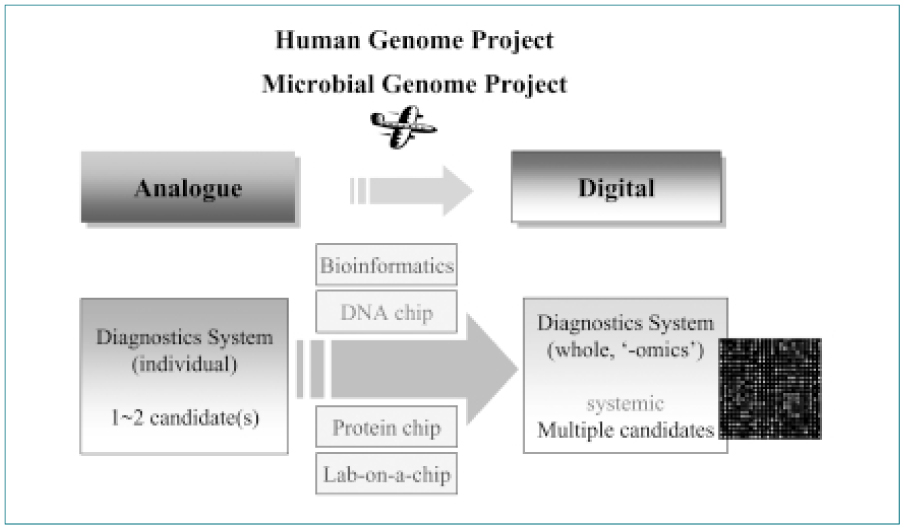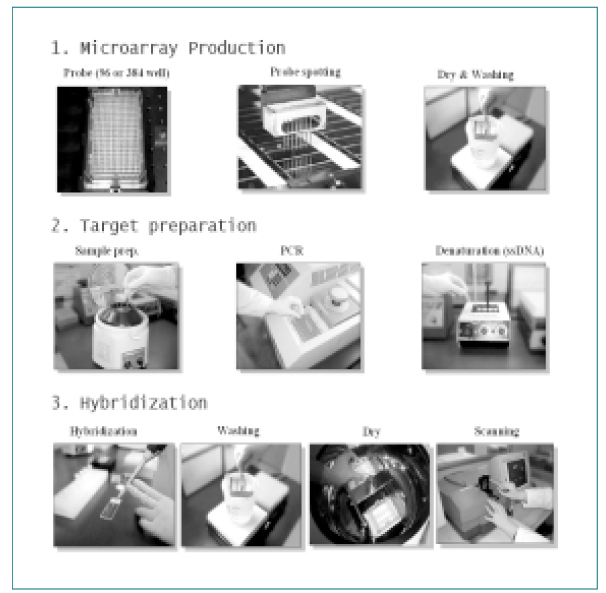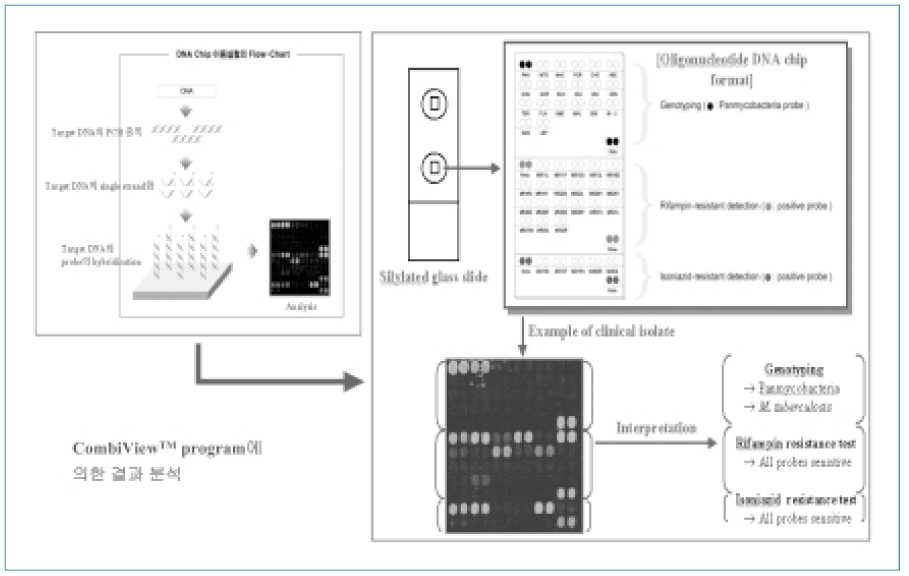J Korean Med Assoc.
2003 Nov;46(11):1016-1024. 10.5124/jkma.2003.46.11.1016.
DNA Chip as a tool for Clinical Diagnostics
- Affiliations
-
- 1Department of Biochemistry, Pusan National University, College of Medicine, Korea. kimcm@pusan.ac.kr, dnachiphk@pusan.ac.kr
- KMID: 2183135
- DOI: http://doi.org/10.5124/jkma.2003.46.11.1016
Abstract
- The identification of the DNA structure as a doublestranded helix consisting of two nucleotide chain molecules was a milestone in modern molecular biology. The DNA chip technology is based on reverse hybridization that follows the principle of complementary binding of doublestranded DNA. DNA chip can be described as the deposition of defined nucleic acid sequences, probes, on a solid substrate to form a regular array of elements that are available for hybridization to complementary nucleic acids, targets. DNA chips based on cDNA clones, oligonucleotides and genomic clones have been developed for gene expression studies, genetic variation analysis and genomic changes associated with diseases including cancers and genetic diseases. DNA chips for gene expression profiling can be used for functional analysis in human cells and animal models, diseaserelated gene studies, assessment of gene therapy, assessment of genetically modified food, and research for drug discovery. DNA chips for genetic variation detection can beused for the detection of mutations or chromosomal abnormalities in cancers, drug resistances in cancer cells or pathogenic microbes, histocompatibility analysis for transplantation, individual identification for forensic medicine, and detection and discrimination of pathogenic microbes. The DNA chip will be generalized as a useful tool in clinical diagnostics in the near future. Labona chip and informatics will facilitate the development of a variety of DNA chips for diagnostic purposes.
Keyword
MeSH Terms
-
Chromosome Aberrations
Clone Cells
Discrimination (Psychology)
DNA*
DNA, Complementary
Drug Discovery
Food, Genetically Modified
Forensic Medicine
Gene Expression
Gene Expression Profiling
Genetic Therapy
Genetic Variation
Histocompatibility
Humans
Informatics
Models, Animal
Molecular Biology
Nucleic Acids
Oligonucleotide Array Sequence Analysis*
Oligonucleotides
DNA
DNA, Complementary
Nucleic Acids
Oligonucleotides
Figure
Reference
-
1. Affara NA. Resource and hardware options for microarray-based experimentation. Briefings in Functional genomics and Proteomics. 2003. 2:7–20.
Article2. Geschwind DH. DNA microarrays : Translation of the genome from laboratory to clinic. Lancet Neurol. 2003. 2:275–282.3. Howbrook DN, van der Valk AM, O'Shaughnessy MC, Sarker DK, Baker SC, Lloyd AW. Developments in microarray technologies. Drug Discov Today. 2003. 15:642–651.
Article4. Huang SH, Triche T, Jong AY. Infectomics : genomics and proteomics of microbial infections. Funct Integr Genomics. 2002. 1:331–344.
Article5. Kiechle FL, Zhang X. The postgenomic era : implications for the clinical laboratory. Arch Pathol Lab Med. 2002. 126:255–262.6. Livesey FJ. Strategies for microarray analysis of limiting amounts of RNA. Briefings in Functional genomics and Proteomics. 2003. 2:31–36.
Article7. Lyons P. Advances in spotted microarray resources for expression profiling. Briefings in Functional genomics and Proteomics. 2003. 2:21–30.
Article8. McGlennen RC. Miniaturization technologies for molecular diagnostics. Clin Chem. 2001. 47:393–402.
Article9. Paolo F, Saul S, Larry JK. Molecular diagnositics : hurdles for clinical implementation. Trends in Molecular Medicine. 2002. 8:264–266.10. Shena M. Microarray Analysis. 2003. Wiely Liss.11. Snijders AM, Pinkel D, Albertson DG. Current status and future prospects of array-based comparative genomic hybridization. Briefings in Functional genomics and Proteomics. 2003. 2:37–45.
Article12. Wang J. From DNA biosensors to gene chips. Nucleic Acids Res. 2000. 15:3011–3016.
- Full Text Links
- Actions
-
Cited
- CITED
-
- Close
- Share
- Similar articles
-
- A Clustering Tool Using Particle Swarm Optimization for DNA Chip Data
- Basic Concept of Gene Microarray
- Implementation of a Particle Swarm Optimization-based Classification Algorithm for Analyzing DNA Chip Data
- The Application of DNA Chip Technology to Identify Herbal Medicines: an Example from the Family Umbelliferae
- Detection of rpoB Gene Mutation in Rifampin-Resistant M. Tuberculosis by Oligonucleotide Chip






